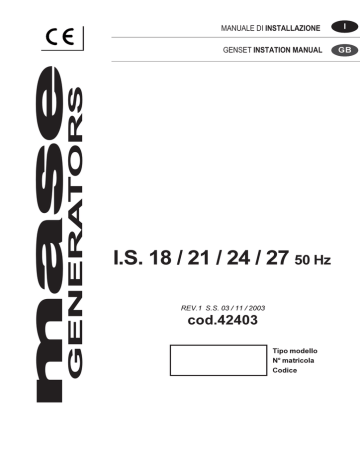- Industrial & lab equipment
- Electrical equipment & supplies
- Power generators
- Mase
- IS 21-24.5
- Installation manual
advertisement

I.S. 18 / 21 / 24 / 27 50
Hz
GB
4.2.2 Typical installation with generator below the water line (Fig.5)
1 Sea exhaust
2 Silencer
3 Exhaust
4 Water filter
5 Main system tap
6 Sea intake
7 Drain tap
8 Antisiphon valve
9 Drainage
A - Pipes - inner diameter Ø75 mm.
B - Pipes - inner diameter Ø25 mm.
C - Pipes - inner diameter Ø16 mm.
D - Pipes - inner diameter Ø14 mm.
4.4.3 Typical installation of generator with gas/ water separating exhaust type GENSEP above the waterline (fig.6)
1 Sea exhaust - gas
2 Sea exhaust - water
3 Gas/water separating exhaust type GENSEP
4 VERNALIFT exhaust
5 Water filter
6 Main system tap
7 Sea intake
8 Drain tap
A - Pipes - inner diameter Ø80 mm.
B - Pipes - inner diameter Ø40 mm.
C - Pipes - inner diameter Ø25 mm.
D - Pipes - inner diameter Ø25 mm.
E - Pipes - inner diameter Ø16 mm.
4.4.4 Typical installation of generator with gas/ water separating exhaust type GENSEP below the waterline (fig.7)
1 Sea exhaust - gas
2 Sea exhaust - water
3 Gas/water separating exhaust type GENSEP
4 VERNALIFT exhaust
5 Water filter
6 Main system tap
7 Sea intake
8 Drain tap
9 Antisiphon valve
10 Drainage
A - Pipes - inner diameter Ø80 mm.
B - Pipes - inner diameter Ø40 mm.
C - Pipes - inner diameter Ø25 mm.
D - Pipes - inner diameter Ø25 mm.
E - Pipes - inner diameter Ø16 mm.
F - Pipes - inner diameter Ø14 mm.
- It is very important to respect the distances shown in the installation diagrams.
- The exhausts (ref.3 of fig.4 and 5 ) have the function of collecting the water left in the exhaust pipes when the generator engine is turned off and preventing that it flows into the engine through the manifold and the exhaust valve. For this reason it is essential to respect the position of the exhaust and the length of the pipes as indicated in the installation diagram.
4.3 Components
The seawater intake system must be independent of that of the boat propulsion engines
1 - 1/2" direct seawater intake.
If the generator is installed at a height of over 1 m above the water line, a non-return valve must be fitted after the seawater intake (Fig.8, Ref.1) to prevent draining the water circuit when the engine is off. If it is drained, the water pump rotor may be damaged during starting; for the same reason, when the generator is started for the first time, the intake pipe must be filled manually from the valve to the pump.
2 - 1/2" ball cock (main system).
3 - 1/2" ball cock (system bleeding).
Serves to drain the cooling system of the generator for general maintenance or for long periods of inactivity.
4 - Water filter (inspectable).
It must efficiently protect the cooling circuit against inflow of mud, sand and seaweed.
Water flow rate IS 21.5-23.5: 40-45 l/min.
The filter mesh must be the fine type. It is recommended to use the type with pitch 2 - 470 micron; different sizes would not allow good filter efficiency.
5 - Antisiphon valve: This is a valve which pressurizes the cooling circuit to atmospheric pressure when the engine is off, preventing the siphonage phenomenon.
It must be used when the base of the generator sits below the water line, and must be positioned at least 50 cm above sea level. (see Fig.5).
The antisiphon valve is inserted between the seawater pump delivery and the mixer as shown in Fig.11.
The antisiphon valve drain pipe must run below it thus preventing water from building up in the pipe, which must always remain empty to allow air to pass through it when the generator is switched off (see Fig.9).
It is recommended to lead the antisiphon valve drain pipe into the bilge, since small amounts of water might seep from it during normal operation.
The cooling circuit is connected to the heat exchanger pipe fitting as shown in Figure 10.
GB
- 11
advertisement
* Your assessment is very important for improving the workof artificial intelligence, which forms the content of this project
Related manuals
advertisement
Table of contents
- 2 Figure
- 6 Schema elettrico
- 9 INFORMAZIONI GENERALI
- 9 Simbologia
- 10 l'installazione e la messa in servizio
- 10 INSTALLAZIONE
- 10 Caratteristiche del vano
- 10 Ancoraggio del gruppo
- 10 Ventilazione
- 10 Sistema di adduzione dell'acqua di mare
- 11 sopra la linea di galleggiamento (fig.4)
- 11 la linea di galleggiamento (fig.5)
- 11 (fig.6)
- 11 (fig.7)
- 11 Componenti
- 12 Sistema di scarico
- 12 CIRCUITO COMBUSTIBILE
- 12 COLLEGAMENTI ELETTRICI
- 12 Allacciamento batteria
- 13 Allacciamento c.a
- 13 Collegamento di terra
- 13 Commutazione generatore - rete
- 13 MOVIMENTAZIONE
- 13 RIFERIMENTI SCHEMA ELETTRICO
- 10 Pictures
- 14 Wiring diagram
- 17 General information
- 18 and set-up
- 18 INSTALLATION
- 18 Housing characteristics
- 18 Generator anchorage
- 18 Ventilation
- 18 COOLING WATER CIRCUIT
- 18 Seawater feed system
- 18 waterline (fig.4)
- 19 water line (Fig.5)
- 19 waterline (fig.6)
- 19 waterline (fig.7)
- 19 Components
- 20 Exhaust system
- 20 5 FUEL CIRCUIT
- 20 6 ELECTRICAL CONNECTIONS
- 20 Battery connection
- 20 Remote control panel connection
- 20 AC connection
- 21 Earth connection
- 21 Generator/mains switching
- 21 HANDLING
- 21 WIRING DIAGRAM REFERENCES